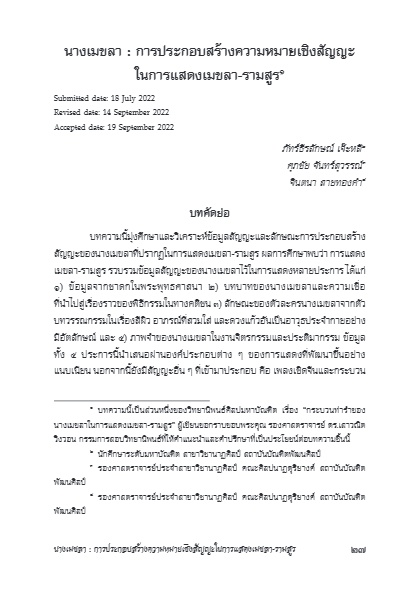นางเมขลา : การประกอบสร้างความหมายเชิงสัญญะ ในการแสดงเมขลา-รามสูร
ภัทร์ธีรลักษณ์ เจ๊ะหลี
ศุภชัย จันทร์สุวรรณ์
จินตนา สายทองคำ
บทคัดย่อ
บทความนี้มุ่งศึกษาและวิเคราะห์ข้อมูลสัญญะและลักษณะการประกอบสร้างสัญญะของนางเมขลาที่ปรากฏในการแสดงเมขลา-รามสูร ผลการศึกษาพบว่า การแสดงเมขลา-รามสูร รวบรวมข้อมูลสัญญะของนางเมขลาไว้ในการแสดงหลายประการ ได้แก่๑) ข้อมูลจากชาดกในพระพุทธศาสนา ๒) บทบาทของนางเมขลาและความเชื่อที่นำไปสู่เรื่องราวของพิธีกรรมในทางคติชน ๓) ลักษณะของตัวละครนางเมขลาจากตัวบทวรรณกรรมในเรื่องสีผิว อาภรณ์ที่สวมใส่ และดวงแก้วอันเป็นอาวุธประจำกายอย่างมีอัตลักษณ์ และ ๔) ภาพจำของนางเมขลาในงานจิตรกรรมและประติมากรรม ข้อมูลทั้ง ๔ ประการนี้นำเสนอผ่านองค์ประกอบต่าง ๆ ของการแสดงที่พัฒนาขึ้นอย่างแนบเนียน นอกจากนี้ยังมีสัญญะอื่น ๆ ที่เข้ามาประกอบ คือ เพลงเชิดจีนและกระบวน ท่ารำรูปยันต์ สัญญะทั้งสองประการนี้เป็นส่วนสำคัญที่ทำให้การแสดงเมขลา-รามสูรมีพัฒนาการถึง ๓ รูปแบบ คือ ๑) กระบวนท่ารำแบบโคมสามใบ ๒) กระบวนท่ารำยันต์สี่ทิศของคุณหญิงนัฏกานุรักษ์ (เทศ สุวรรณภารต) และ ๓) กระบวนท่ารำยันต์สี่ทิศของท่านผู้หญิงแผ้ว สนิทวงศ์เสนี กระบวนท่ารำสองประการหลังมีนัยของการแสดงที่แตกต่างกันออกไป กล่าวคือทำให้เกิดความมงคลของพื้นที่การแสดง เพลงเชิดจีนและกระบวนท่ารำรูปยันต์ทำให้การแสดงเมขลา-รามสูรเป็นต้นแบบสำคัญของกระบวนท่ารำของการแสดงอื่น ๆ ที่เกิดขึ้นในภายหลัง จึงกล่าวได้ว่าข้อมูลสัญญะนับเป็นองค์ประกอบสำคัญต่อการสร้างสรรค์ตัวละครนางเมขลาในการแสดงเมขลา-รามสูรทั้งในส่วนที่เกี่ยวข้องกับนางเมขลาโดยตรง หรือสัญญะอื่น ๆ ที่เข้ามาประกอบบนพื้นฐานความตั้งใจ ความจงใจ อย่างประณีตบรรจงและมีเอกภาพ
คำสำคัญ : การแสดงเมขลา-รามสูร, การประกอบสร้าง, สัญญะ
(ตีพิมพ์ใน วารสารไทยศึกษา ปีที่ 19 ฉบับที่ 1 (มิถุนายน 2566) หน้า 27-65)
Mekhala: The Construction of Semiotic Analysis in Mekhala-Ramasun Performances
Phattheraluk Jelee
Supachai Chansuwan
Jintana Saitongkum
Abstract
The study for this paper analyzed semiotic information and the character of semiotic construction of Mekhala in Mekhala-Ramasun performances. The results revealed that Mekhala-Ramasun performances have taken elements regarding the semiotics of Mani Mekhala from different aspects of representations of the Mekhala-Ramasun story as follows: 1) information from Jatakas in Buddhism; 2) the role of Mekhala and beliefs reflected in rituals that appear in folklore; 3) the creation of Mekhala mythology in terms of the skin color, outfits and the crystal ball, with lightning regarded as her personal identity weapon; and 4) Mekhala, as depicted in painting and sculpture. Elements from these four sources can be found in various performance aspects that have been harmoniously developed. Furthermore, other semiotic elements have been introduced through the Choet-Chin song and Yantra dances. These are important elements that have resulted in performances in three styles: 1) the Khom sam bai dance; 2) the Yantra dance of Khunying Natthakanurak (Thet Suwanpharata or Thes Suvarnabharata); and 3) the Yantra dance of Thanphuying Paew Sanidvongseni. The latter two dances have created different connotations of Mekhala performances that developed into auspicious performance area. Choet-Chin song and Yantra dances have developed Mekhala performances as the prototype for dance gestures for other performances that were created later. In conclusion, semiotic are an important component of the Mekhala-Ramasun story in creating the Mekhala character that appears in Mekhala-Ramasun performances. This also has a direct impact on the character of Mekhala and other types of performance as the semiotics were created with specific intention, delicacy and integrity.
Keywords: Mekhala-Ramasun Performance, Construction, Semiotic
(Published in Journal of Thai Studies Volume 19 Number 1 (June 2023) Page 27-65)
บทความ/ fulltext : 2_Phattheraluk.pdf
